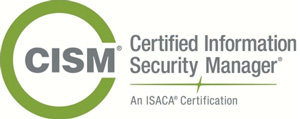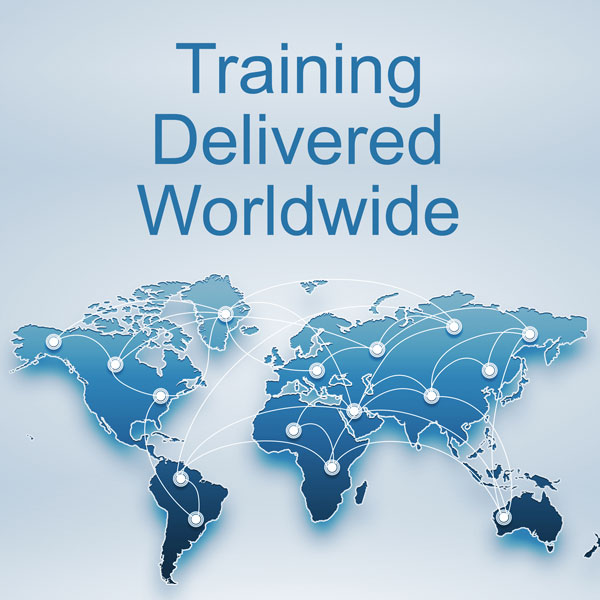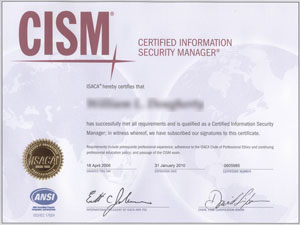CISM ® – Certified Information Security Manager
Training Courses and Certification Exam Preparation (Bootcamp)
We also deliver all our courses online through live interactive video sessions. Discover our Certifying Training Options.
We have advised more than 400 companies and trained over 1500 professionals. Will you be next?
Next courses (more below)
IS security and governance
CISM is the only globally
The CISM Job Practice Area consists of five “domains”, 37 “tasks” and 60 “knowledge statements”. Because the different tasks refer to the relevant COBIT processes, COBIT is an integral part of the CISM training and certification.
This training is

CISM ISACA Training
ACTAGIS, based on a long term partnership with the ISACA Swiss Chapter, proposes learning and preparation classes for all ISACA certifications (also worldwide for in-house trainings).

We guarantee your exam success
Nearly 100% success rate!
We will support you until you pass the exam of the course in which you enroll (some conditions apply). We offer the official mock exams to help you prepare.

Swiss Quality around the world
Our attention to detail, staying up to date, all reflect our commitment to quality. Our trainers bring real-life project experience in implementing frameworks and programs in large organizations.

Free consulting session included
Most of our training programs include a supplementary free online consulting session to help you implement your project in your organisation.

Competitive pricing
To ensure that our courses are available to all sizes of companies, we practice competitive pricing.

Learn from where you are
Our courses are delivered in a traditional classroom setting, as well as live online with an instructor. Certain courses are also available in a self-study format.
Modular approach
The course is presented in two modules:
- Module 1 is a detailed 10 day course covering all CISM material
- Module 2 (Exam Bootcamp) is a 3 day exam preparation session

Module 1
A detailed 10 day course
In this module, we will go through all CISM themes, in a detailed manner. This module contains:
- Theoretical and conceptual sections
- Case studies
- Tests by theme
- Group work
- Interactive sessions
Module 1 is mostly aimed at the following profiles:
- Chief Information Officer
- Security Officer
- IT project manager
- Compliance Officer
- IT Architect
- IT Resources Manager
Module 1 of this course is subdivided into 9 chapters, covering all CISM Job Practice Areas in details, by going through the following chapters:
- Introduction (1 day): ISACA, CISM Job Practice Areas, course concept, learning technique, personal study
- Basics (2 days): IT risk management & ICS (Internal Control System), IT governance
- Application lifecycle (1 day): Project management, software development, integration, security, user controls
- Organisational security (1 day): Economic & IT criminality, risk analysis, cultural aspects of security, awareness-training
- Risk management (1 day): Identification, assessment and management of IT risks. Comparison of various frameworks such as ISO 27005, RiskIT
- Performance management (1 day): Maturity models, Key Performance Indicators, Balanced Score Card, Benchmarking
- Security management (1 day): Design and implementation of an Information Systems Management System (ISMS), ISO 2700x, CobiT Security Baseline, certification
- Technical security (1 day): Physical security, IT protection against fire, telecommunication security, encryption
- Incident management (1 day): Incident management, IT Disaster Recovery, Business Continuity Management (BCM)
Days
Courses highlighted in green are rapidly filling up.
Don't miss out.
Upcoming courses
Course dates can be based on your requirements. Please contact us for the corresponding in-house or public session trainings, so that we can propose sessions taking into account your availability.
Module 2 – Exam Bootcamp
A 3 day exam preparation session
- Learning Objectives
- Target Audience
- Our added value
- Course content
- References to job descriptions and standards
- Certification
- Examination fee
This training is intended to professionals who have already had IT experience. It is recommended for the participants to have a detailed knowledge of the CISM Job Practice Area and having read through the CISM Review Manual prior to taking the course and, ideally, to have several years of professional experience in different areas of IT. The CISM exam preparation course is aimed at all persons who deal with the governance, audit or security of information systems, such as:
- Chief Information Officer
- Security Officer
- IT project manager
- Compliance Officer
- IT Architect
- IT Resources Manager
The first two and a half days of the course consist of an intensive and systematic review of all tasks within the CISM Job Practice Area. Here the aspects which are important from the examination perspective are presented, without going into the details of each task, which is why some level of expertise is required. Those who would like to study all CISM tasks in detail should join our advanced course.
Following the initial phase, a realistic test examination is organized (in English). After this test exam, we will discuss the results during the last day of the training. You will also be provided with a second test, which you can perform on your own time. We will then correct it and send you back your results.
The domains covered by this certification are:
- Information Security Governance (24%)
- Information Risk Management (30%)
- Implementation of an Information Security Program (27%)
- Information Security Incidents Management (19%)
Domain 1 – Information Security Governance – (24%)
Establish and/or maintain an information security governance framework and supporting processes to ensure that the information security strategy is aligned with organizational goals and objectives.
Task Statements
- Establish and/or maintain an information security strategy in alignment with organizational goals and objectives to guide the establishment and/or ongoing management of the information security program.
- Establish and/or maintain an information security governance framework to guide activities that support the information security strategy.
- Integrate information security governance into corporate governance to ensure that organizational goals and objectives are supported by the information security program.
- Establish and maintain information security policies to guide the development of standards, procedures and guidelines in alignment with enterprise goals and objectives.
- Develop business cases to support investments in information security.
- Identify internal and external influences to the organization (e.g., emerging technologies, social media, business environment, risk tolerance, regulatory requirements, third-party considerations, threat landscape) to ensure that these factors are continually addressed by the information security strategy.
- Gain ongoing commitment from senior leadership and other stakeholders to support the successful implementation of the information security strategy.
- Define, communicate, and monitor information security responsibilities throughout the organization (e.g., data owners, data custodians, end-users, privileged or high-risk users) and lines of authority.
- Establish, monitor, evaluate and report key information security metrics to provide management with accurate and meaningful information regarding the effectiveness of the information security strategy.
Domain 2 – Information Risk Management – (30%)
Manage information risk to an acceptable level based on risk appetite in order to meet organizational goals and objectives.
Task Statements
- Establish and/or maintain a process for information asset classification to ensure that measures taken to protect assets are proportional to their business value.
- Identify legal, regulatory, organizational and other applicable requirements to manage the risk of noncompliance to acceptable levels.
- Ensure that risk assessments, vulnerability assessments and threat analyses are conducted consistently, at appropriate times, and to identify and assess risk to the organization’s information.
- Identify, recommend or implement appropriate risk treatment/response options to manage risk to acceptable levels based on organizational risk appetite.
- Determine whether information security controls are appropriate and effectively manage risk to an acceptable level.
- Facilitate the integration of information risk management into business and IT processes (e.g., systems development, procurement, project management) to enable a consistent and comprehensive information risk management program across the organization.
- Monitor for internal and external factors (e.g., key risk indicators [KRIs], threat landscape, geopolitical, regulatory change) that may require reassessment of risk to ensure that changes to existing, or new, risk scenarios are identified and managed appropriately.
- Report noncompliance and other changes in information risk to facilitate the risk management decision-making process.
- Ensure that information security risk is reported to senior management to support an understanding of potential impact on the organizational goals and objectives.
Domain 3 – Information Security Program Development and Management – (27%)
Develop and maintain an information security program that identifies, manages and protects the organization’s assets while aligning to information security strategy and business goals, thereby supporting an effective security posture.
Task Statements
- Establish and/or maintain the information security program in alignment with the information security strategy.
- Align the information security program with the operational objectives of other business functions (e.g., human resources [HR], accounting, procurement and IT) to ensure that the information security program adds value to and protects the business.
- Identify, acquire and manage requirements for internal and external resources to execute the information security program.
- Establish and maintain information security processes and resources (including people and technologies) to execute the information security program in alignment with the organization’s business goals.
- Establish, communicate and maintain organizational information security standards, guidelines, procedures and other documentation to guide and enforce compliance with information security policies.
- Establish, promote and maintain a program for information security awareness and training to foster an effective security culture.
- Integrate information security requirements into organizational processes (e.g., change control, mergers and acquisitions, system development, business continuity, disaster recovery) to maintain the organization’s security strategy.
- Integrate information security requirements into contracts and activities of third parties (e.g., joint ventures, outsourced providers, business partners, customers) and monitor adherence to established requirements in order to maintain the organization’s security strategy.
- Establish, monitor and analyze program management and operational metrics to evaluate the effectiveness and efficiency of the information security program.
- Compile and present reports to key stakeholders on the activities, trends and overall effectiveness of the IS program and the underlying business processes in order to communicate security performance.
Domain 4 – Information Security Incident Management – (19%)
Plan, establish and manage the capability to detect, investigate, respond to and recover from information security incidents to minimize business impact.
Task Statements
- Establish and maintain an organizational definition of, and severity hierarchy for, information security incidents to allow accurate classification and categorization of and response to incidents.
- Establish and maintain an incident response plan to ensure an effective and timely response to information security incidents.
- Develop and implement processes to ensure the timely identification of information security incidents that could impact the business.
- Establish and maintain processes to investigate and document information security incidents in order to determine the appropriate response and cause while adhering to legal, regulatory and organizational requirements.
- Establish and maintain incident notification and escalation processes to ensure that the appropriate stakeholders are involved in incident response management.
- Organize, train and equip incident response teams to respond to information security incidents in an effective and timely manner.
- Test, review and revise (as applicable) the incident response plan periodically to ensure an effective response to information security incidents and to improve response capabilities.
- Establish and maintain communication plans and processes to manage communication with internal and external entities.
- Conduct post-incident reviews to determine the root cause of information security incidents, develop corrective actions, reassess risk, evaluate response effectiveness and take appropriate remedial actions.
- Establish and maintain integration among the incident response plan, business continuity plan and disaster recovery plan.
- CISA tasks: some
- CISM tasks: all
- CGEIT tasks: some
- CRISC tasks: some
- COBIT5 processes: (all)
The CISM exam is booked separately through ISACA.
It lasts 4 hours (240 minutes) and contains 150 multiple-choice questions.
The cost is US$ 575 for ISACA members and US$ 760 for non-members.
Days
Courses highlighted in green are rapidly filling up.
Don't miss out.
We can also help you implement Cybersecurity in your company

Our services
Secure your business in alignment with the stakeholders needs and augment your level of protect in a proactive way.
- Strategy creation
- Security Management System
- Security Dashboard
- Architectures
- Training & Awareness
- Packaged security services
- CSO, CISO services

The training is a combination of directly applicable theory, hands-on exercises, feedback from experience and class interaction.
%
Exam pass rate
You will be well prepared for the exam. Counting all our students, almost 100% have been successful.

All our courses are up to date. They have been adapted to the latest changes of the different exams. We are in constant contact with each certification organisation.
The training is a combination of directly applicable theory, hands-on exercises, feedback from experience and class interaction.
You will be well prepared for the exam. Counting all our students, almost 100% have been successful.
All our courses are up to date. They have been adapted to the latest changes of the different exams. We are in constant contact with each certification organisation.
Interested? Ask us more!






ACTAGIS Academy
Governance
Informatique
Sécurité & Gestion du Risque
Business
Continuity
Gestion de la
Qualité









































